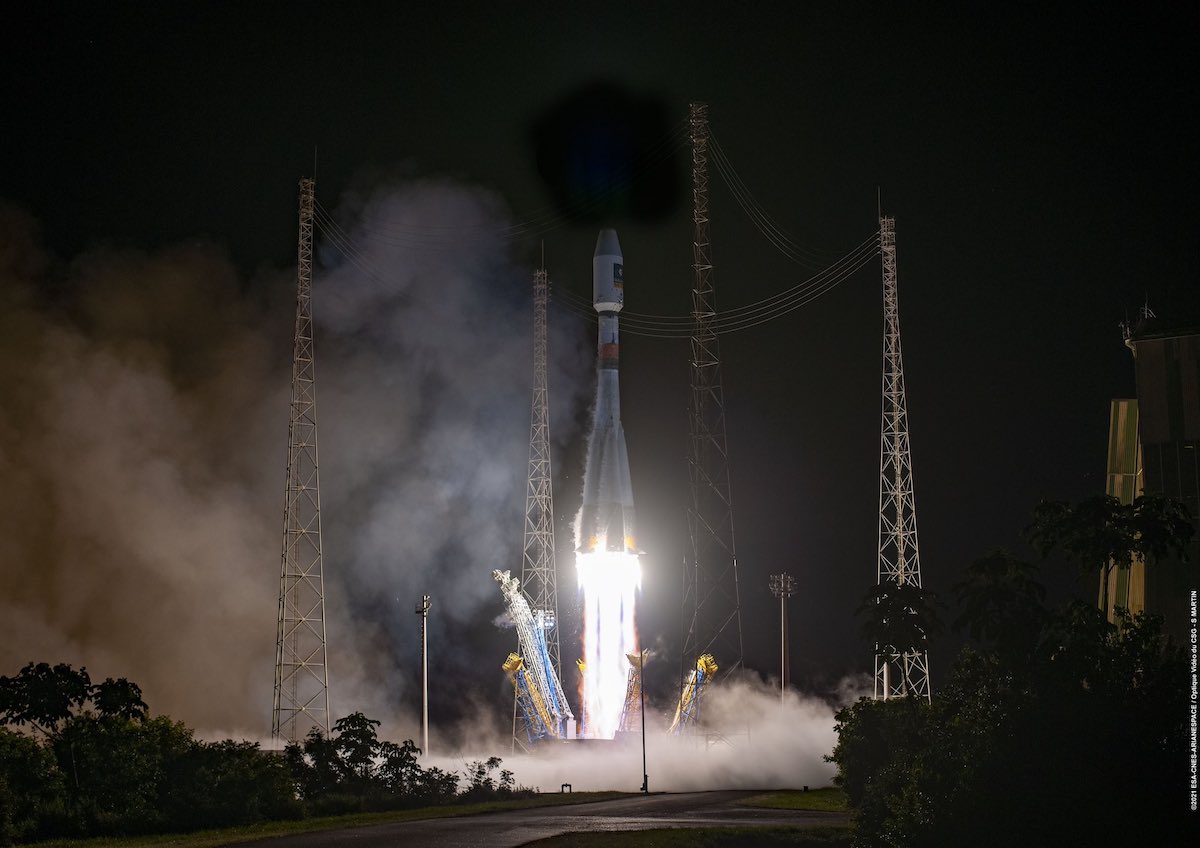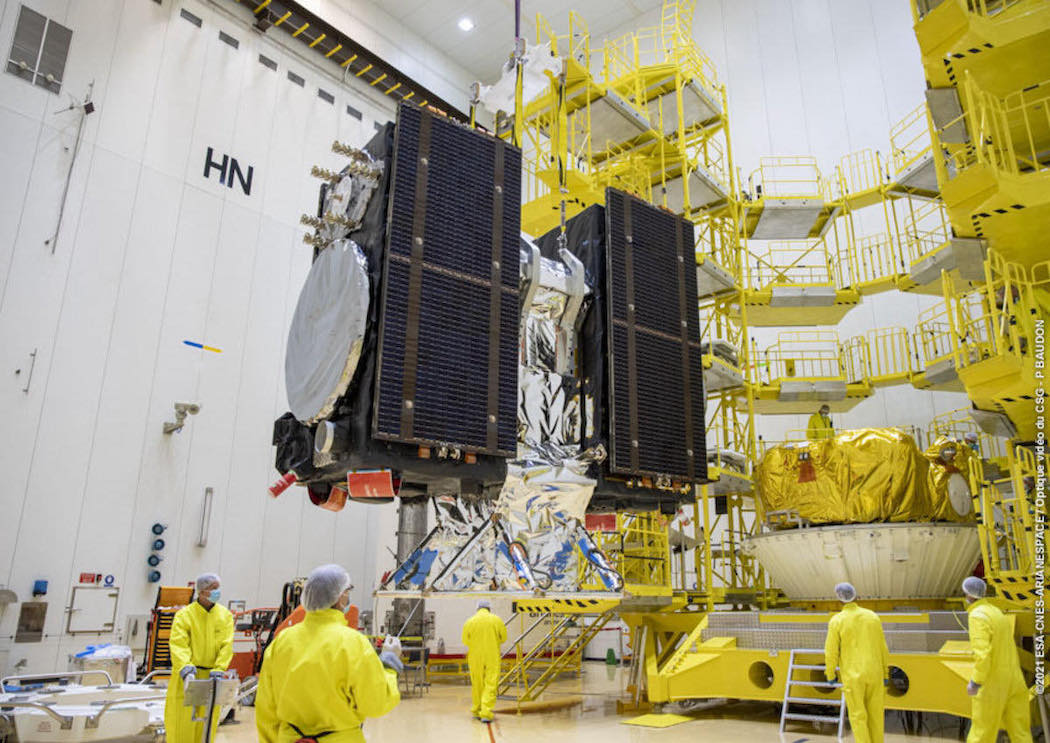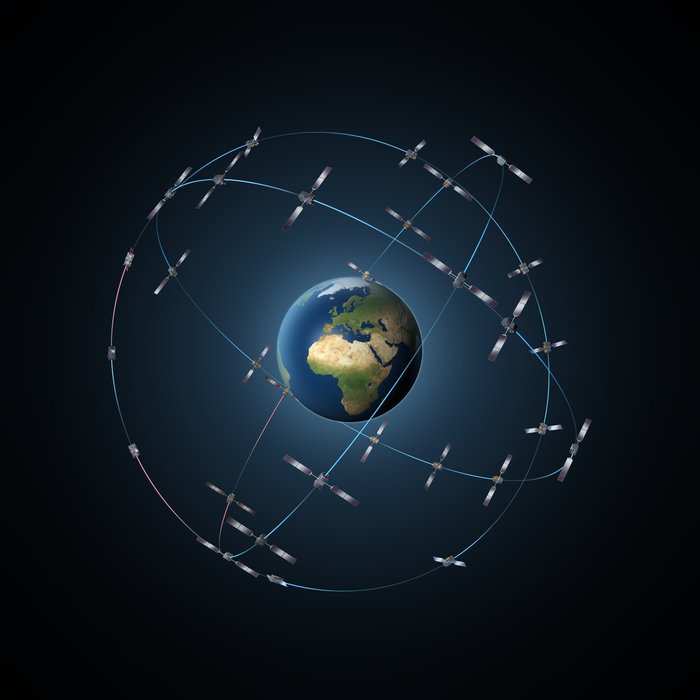
Deployment of Europe’s independent Galileo navigation network resumed Saturday night with an on-target launch of two satellites aboard a Soyuz rocket, the final Arianespace mission from French Guiana before the historic liftoff of the James Webb Space Telescope later this month.
Running four days late due to bad weather and a problem with a downrange telemetry station, a Soyuz launcher fired its kerosene-fueled engines and vaulted away from the Guiana Space Center on the northeastern shore of South America at 7:19:20 p.m. EST Saturday (0019:20 GMT Sunday).
The liftoff occurred at 9:19 p.m. local time at the launch base in French Guiana, beginning the 26th Soyuz mission from the tropical spaceport.
Two previous launch attempts were scrubbed due to bad weather, and officials called off another countdown due to the unavailability of a downrange shipborne tracking station in the Atlantic Ocean.
The Russian-made Soyuz ST-B rocket took off with nearly a million pounds of thrust and darted through scattered clouds, arcing to the northeast over the Atlantic Ocean. The Soyuz shed four first stage boosters two minutes into the mission, then jettisoned its clamshell-like nose cone after soaring above the thickest layers of the atmosphere.
The core stage shut down and released about five minutes after liftoff, and a third stage engine ignited to continue the flight into space. The Soyuz third stage finished its work about nine minutes into the flight, then deployed a Russian Fregat upper stage for the final maneuvers to place the Galileo satellites into orbit.
Liftoff of a Soyuz rocket from French Guiana, carrying Europe’s 27th and 28th operational Galileo navigation satellites. https://t.co/FAcojHwAD9 pic.twitter.com/j3nuV9x2j1
— Spaceflight Now (@SpaceflightNow) December 5, 2021
The Fregat engine fired first to reach an egg-shaped transfer orbit, then the rocket coasted more than three hours before reigniting to circularize its orbit at an altitude of more than 14,600 miles (23,500 kilometers) and an inclination of 57.1 degrees to the equator.
The two 1,576-pound (715-kilogram) Galileo satellites, mounted side-by-side during launch, deployed from the Fregat upper stage around 11:11 p.m. EST (0411 GMT).
A few minutes later, telemetry from the rocket confirmed a successful spacecraft separation.
Ground teams at a Galileo control center in Oberpfaffenhofen, Germany, took command of the spacecraft. The satellites unfurled their solar panels as panned, officials said.
The spacecraft will complete a series of post-launch tests before entering operational service in a few months.
“Tonight, we have a fantastic success again for the Galileo program,” said Paul Verhoef, director of navigation at the European Space Agency.
Designed for 12-year missions, the new spacecraft will join 26 Galileo satellites already in orbit providing navigation services around the world for the European Union’s mulbillion-euro flagship space program. Ten launches of Soyuz and Ariane 5 rockets from French Guiana from October 2011 through July 2018 deployed the operational Galileo satellites, which are spread out in three orbital planes around 14,400 miles (23,200 kilometers) above Earth.
The full constellation needs 30 satellites, including 24 active platforms and six spares.
“The purpose of the coming up launch of Galileo is to complete the deployments of the satellites and the population of the different orbital planes to ensure that the constellation is complete,” said Andrea Cotellessa, head of the Galileo space segment management office at the European Space Agency. “Our constellation requires eight operational satellites and two spare satellites per plane, and this has not been achieved yet.”

Galileo satellites are already beaming navigation signals to users around the world. More than 2 billion smartphones have been sold with Galileo-enabled chipsets, allowing users to locate themselves with navigation signals from Galileo satellites alongside data from the U.S. military’s Global Positioning System network.
When fully operational, the Galileo network will provide independent navigation fixes for users without needing GPS signals. With both networks available, combining Galileo and GPS data can give users a more precise position estimate.
The launch Saturday night was the final mission from the spaceport in French Guiana before liftoff Dec. 22 of the James Webb Space Telescope, a $9.7 billion observatory developed by NASA, ESA, and the Canadian Space Agency.
Webb, the most expensive space science mission in history, will blast off on top of a heavy-lift Ariane 5 rocket. Officials at the Guiana Space Center require about two weeks to reconfigure ground infrastructure between launches, meaning the Soyuz flight needs to get off the ground by around Dec. 8 to ensure the Webb launch remains on schedule.

The two Galileo spacecraft launched Saturday night were built by OHB in Bremen, Germany. The L-band navigation payloads on each satellite was supplied by SSTL in the United Kingdom.
The satellites are the first two of 12 Galileo spacecraft ordered in a third batch contract from ESA in 2017. The “Batch 3” satellites, with the same capabilities as the previous 26, will sustain the Galileo constellation until a new generation of spacecraft is ready for launch.
Over the next few years, three Soyuz launches and three flights of Europe’s new Ariane 6 will rocket will each carry two Galileo satellites into orbit.
The second-generation satellites should begin launching by the end of 2024, according to ESA, which manages spacecraft development for the Galileo system on behalf of the European Commission, the EU’s executive body.
“They will be more powerful,” Verhoef said before this week’s launch. “They will be, as a result, also heavier, but they will have more capabilities. In particular, they will be fully flexible, fully digital, so we can re-program them in orbit.
“At the moment with the first generation, if we want to provide significant new services, we’re going to have to bring completely new satellites into orbit,” Verhoef said. “With the second generation, we have decided to do it differently and allow this capability, de facto, to be on the satellites, so we can change things as markets demand it in a relatively quick way.”
Earlier this year, the European Commission and ESA awarded contracts to Airbus and Thales Alenia Space for 12 second-generation, or G2, Galileo satellites. Each company won a deal for six spacecraft, which will carry navigation payloads built on the European continent, rather than by SSTL in the UK.
SSTL was excluded from the new generation of Galileo satellites after Brexit. European officials required sensitive elements of the Galileo program to come from EU member states.
Email the author.
Follow Stephen Clark on Twitter: @StephenClark1.
from Spaceflight Now https://ift.tt/3y3roTy
via World Space Info







0 comments:
Post a Comment